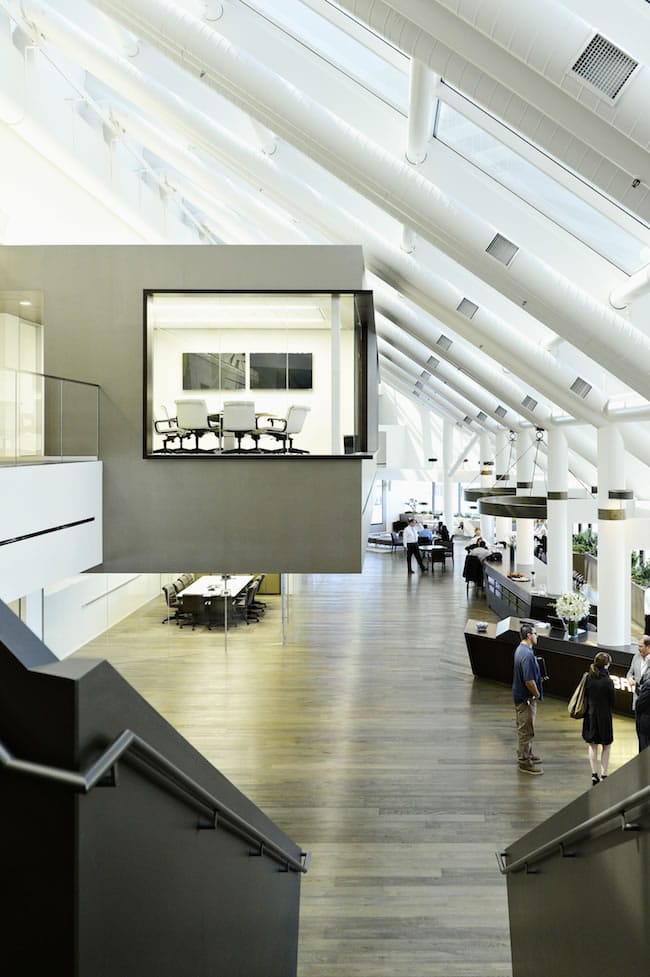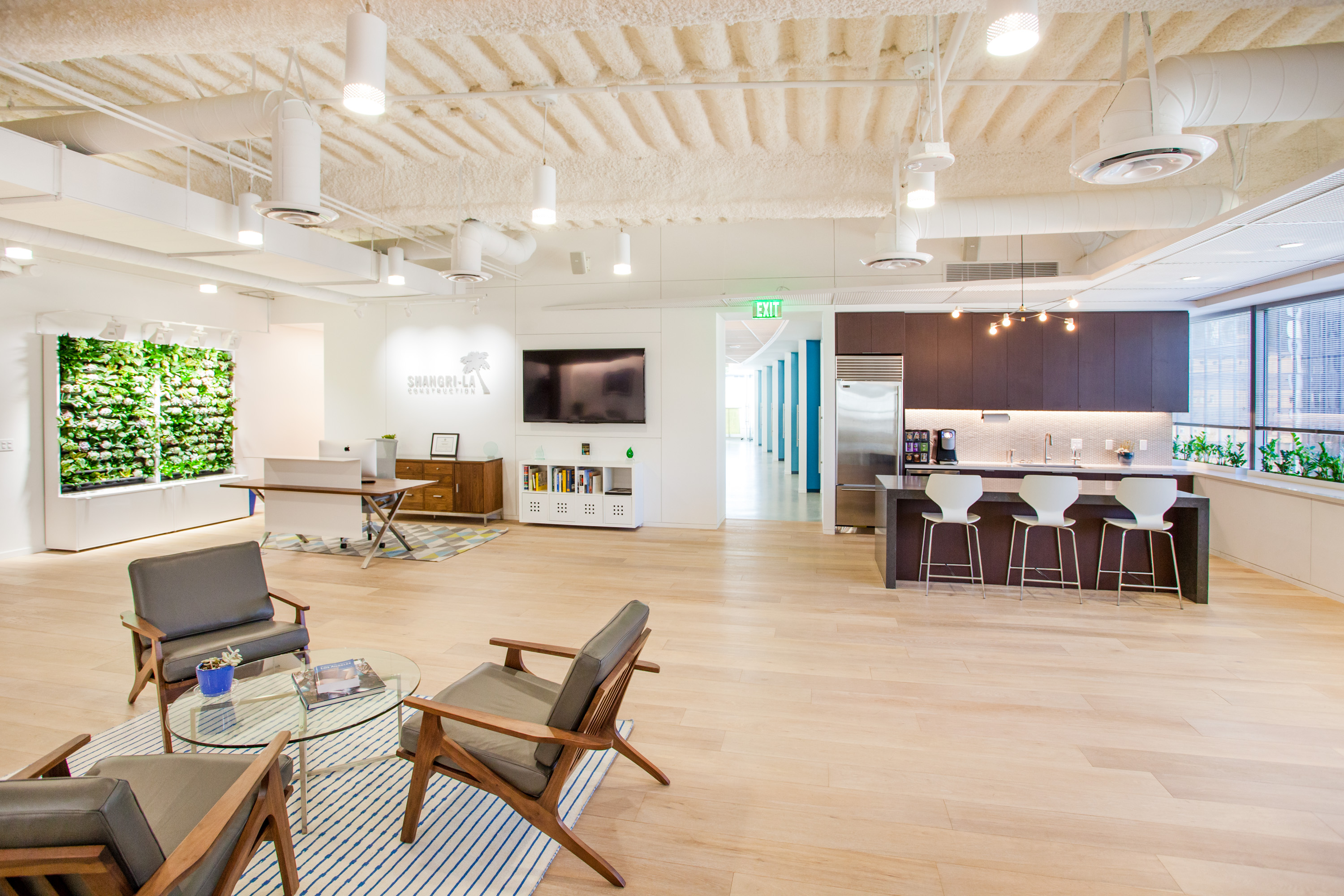
Shangri-La Construction Headquarters improvements include new non-load bearing partitions, new floor and wall finishes, new power, data, and A/V. The project is pursuing LEED Certification and WELL Pilot Certification. [Photo: Matt Waugh]
A quest to design healthier spaces for the people that occupy them creates a new standard in the building industry.
Seven years ago, a lightbulb went off in Paul Scialla’s head: now that we’ve learned to design buildings that are healthy for the environment, isn’t it time to start designing them to be healthier for people? At the time, Scialla had just been made a partner at Goldman Sachs; he had devoted nearly half of his career to Wall Street. But never one to question an intuitive thought—or shy from a challenge—he started to investigate. “I took a look at how the word ‘sustainability’ was being used and felt there was a bit of a gap in thought,” he says. “So I started thinking about how far we can push what that word really means and advance the notion of human, or biological, sustainability.”
Scialla talked to architects and designers of all stripes. He spoke with health experts, real estate professionals, and scientists in fields ranging from ergonomics and acoustics to sociology and psychology. He learned that humans spend an average of 90% of their time indoors and that indoor air quality in approximately 70% of buildings is worse than outdoor air quality. Volumes have been written on the correlation between the design of the built environment and human health, especially in the workplace. Some connections are straightforward—most people have experienced the off-gassing of new carpet or wall finishes, for example, and understand that the release of harmful volatile organic compounds (VOCs) can lead to headaches, nausea, and fatigue. Others correlations are more subtle. The wavelength of light used to illuminate our workspaces during the day can lead to sleeplessness at night; the design of stairwells can entice us to use them or predispose us to head for the elevator; even the color and texture of wall coverings can influence whether we feel perky and productive throughout the day or bored and disengaged.
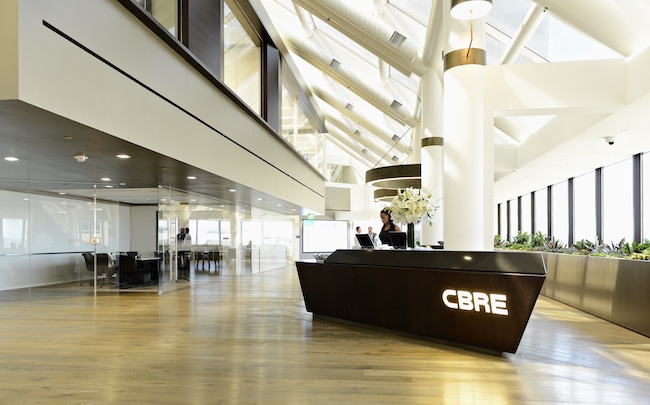
CBRE, the world’s largest commercial real estate development company, has the first office space designed and built using Delo’s WELL Building Standard, as part of a pilot program in 2013. [Photo: Courtesy of CBRE]
“I found that this concept appeals to anyone,” Scialla says. “Everyone cares about their own health, their well-being and that of their family; and when they understand that our built envi- ronment can have a meaningful impact on how we feel, everyone gets excited.”
Scialla also found, despite the overwhelming evidence linking design and public health, that there was not yet a comprehensive guide, much less a standard, for integrating this knowledge into the real estate industry. So he set out to build one.
“I recognized early on that if this can be accomplished it certainly needs to be shared, and it needs to be scaled globally,” he says.
The economic prospects were intriguing. “Real estate is the largest asset class in the world with $150 trillion value, globally,” Scialla says. “What if we looked to intelligently infuse that with the fastest growing, and arguably most important industry—health and wellness—in itself a $2 trillion annual spend?”
DELOS ADVISORY BOARD Dr. Deepak Chopra: Founder of the Chopra Foundation Dick Gephardt: Former US Congressman and House of Representatives Majority Leader Leonardo DiCaprio: Sustainability advocate, actor Nicholas LaRusso: Medical Director of the Mayo Clinic Center for Innovation Rick Fedrizzi: President & CEO of the US Green Building Council Dolly Lenz: Real estate broker Mel Martinez: Former Chairman of the Republican National Committee, HUD Secretary, and US Senator Jason McLennan: CEO, International Living Future Institute Dr. Michael Roizen: Chief Wellness Officer at the Cleveland Clinic Sue Firestone: Founder and Chairman of Smith/Firestone Associates
The Science of a Healthy Building
After a couple years of person ally vetting the concept, Scialla formed Delos: a research platform, technology incubator, and wellness real estate development company meant to put his ideas into practice. Named after the Greek island that was the mythological home of the gods and a place of eternal good health, the company emerged as a hive-like laboratory, convening some of the top minds in health, design, and real estate. It’s not just the health and design communities that are involved, either. The Delos advisory board is stacked with political and cultural heavy- weights, including former HUD secretary and U.S. senator Mel Martinez and actor Leonardo Di Caprio—figures that make the WELL Building initiative a truly interdisciplinary effort and garner support and from a broad base of stakeholders.
“We really took our time to get this concept right—academically, medically, politically,” Scialla says. The “roster of minds” he assembled to flesh out the concept and begin building prototypes was not the sort of utopist, fresh-from-graduate-school bunch you might expect. The 40-plus staff members are rich in both Ph.D.’s and real world experience, their resumes populated with names such as the Columbia University Medical Center, the University of California Berkeley’s Center for the Built Environment, and the United Nations Millennium Villages Project.

Currently under construction, 85 Bluxome Street is designed to be a Class A, LEED Gold certified, ground-up office development located in the South of Market area of San Francisco. [Photo: Courtesy of Bluxome Partners, LLC]
“We’re linking health effects to solutions through elements,” says Nathan Stodola, director of the WELL Building Standard and a mechanical engineer by trade. “For example, a number of cohort-based studies show that people who walk 3,000 steps more per day will have certain benefits to their cardiovascular system over the long term, while other studies show that when you design spaces like ‘X’, you’ll get people to walk more.” From there, Stodola’s team worked backward to come up with a coordinated, implementable set of practices to support each health outcome that could be correlated to building design. Working in this fashion, 102 performance metrics were established in seven conceptual arenas: air, water, nourishment, light, fitness, comfort, and mind. “The design interventions that we’ve specified in the Well Building Standard are linked to a measurable out-come, which has been shown to have these health benefits,” Stodola says.
Our modern healthcare system focuses on addressing health after sickness has already struck a person. But with the increased prevalence of chronic diseases such as diabetes, cardiovascular disease, and cancer—not to mention the immense costs of treating these ailments—the healthcare community has put more and more emphasis on lifestyle-oriented and preventative approaches to health. The WELL Building Standard provides a way to apply this line of thinking to the built environment and has emerged through a rigorous three-part peer review process. A committee of scientists, each with very specific areas of expertise, was convened to establish minimum benchmarks for the quality of water, light, air, and other components of the built environment that directly affect human health. A team of design and construction industry professionals analyzed the implementability of the standards, giving feedback on the best way to incorporate them into current building practices. Finally, a medical review board gave suggestions on how the standards could be implemented for the greatest leverage on public health outcomes.

“The WELL Building Standard takes us away from the sick-building syndrome,” says Dr. Michael Roizen, chief wellness officer at the Cleveland Clinic. Dr. Roizen, who headed up the medical review team along with Dr. Nicholas LaRusso of the Mayo Clinic and a number of other nationally respected physicians, points out that increasing the health of buildings in which we spend our time ripples out with significant benefits to society at large by reducing the burden of healthcare costs. “It should help people see how their choices affect their health costs,” says Roizen, emphasizing that policymakers should take note of the potential to reduce taxpayer costs associated with healthcare.
Delos, IWBI, & Bill Clinton
Delos invested nearly seven years of research and development in creating the development and framework of the WELL Building Standard, which was unveiled in October of 2014 (version one). The launch marked the end of a two-year pilot program in which a number of projects were designed and built using the standard, which provided real world feedback on what it takes to implement the criteria across a number of building typologies. There are now condominiums in Manhattan, hotel rooms in Las Vegas, restaurants in California, Colorado, and Illinois, and more that show how healthy buildings look, feel, and function in these contexts. CBRE, the world’s largest commercial real estate development company, built a new global corporate headquarters in Los Angeles as part of the pilot program in 2013, becoming the first office space to do so. Other pilot projects tested the concept in the retail, multi-family, institutional, and mixed-use sectors, including sites in Melbourne, Shanghai, Mexico City, and New Delhi. As of early 2015, nearly 8 million square feet of what has been termed “wellness-infused” real estate has been built or is registered for certification— about 30% of it overseas.
As things progressed, Stodola says it became clear that the WELL building concept was not something to be housed within a single development company. “Real estate development is so capital intensive, we felt that roll-out would be too slow; we needed a way to share all the research we’d done with many more projects influencing many more people.” Thus in 2013, Delos launched the International WELL Building Institute (IWBI) to administer the WELL Building Standard, which is now available to the general public. IWBI is partnered with the Green Building Certification Institute (GBCI), the organization responsible for LEED certification according to the standards of the USGBC, who is now providing third-party certification for the WELL Building Standard.

Designed by HOK, the William Jefferson Clinton Children’s Center in Port-au-Prince, Haiti is aiming for WELL Certification and LEED Platinum certification. [Photo: Courtesy of HOK]
Notably, IWBI is not a for-profit or a not-for-profit company. It is structured as a B-corp, a relatively new corporate structure in the US that is intended to balance profitability with public benefits. IWBI will direct at least 51% of net profits toward charitable causes related to its mission of health in the built environment. Scialla is a member of the Clinton Global Initiative (CGI), an organization formed by the Clinton family to address the biggest challenges of our times. “[This] will literally change the way we live and work in a very positive way,” said former President Clinton at the CGI annual meeting in 2012 in acknowledging the commitment to improved public health embodied in the WELL Building Standard.
IWBI is collaborating with the USGBC to build the William Jefferson Clinton Children’s Center in Port-au-Prince, Haiti, an orphanage and model for resilient construction techniques that will be built according to LEED and WELL building standards. As Scialla says, “Health and well-being in the built environment should not be considered a privilege, it should be considered a right.”
Industry Applications
In regards to the LEED-WELL connection, “[the WELL Building Standard] starts with sustainability as a platform,” says Michelle Moore, senior vice president at IWBI, “but takes it a step further and expands on those metrics to make sure buildings are performing for the whole reason they exist, which is for the people who inhabit them.” Moore, who comes from the green building industry (she is a former senior vice president of the USGBC; her last job was as Obama’s Chief Sustainability Officer), emphasizes that project managers seeking LEED and WELL certification will experience a highly streamlined process in registering and certifying their projects. There are about a dozen metrics where WELL overlaps with LEED and the Living Building Challenge, but Moore says “we are committed to a principle of no duplication; we want to add value, not administrative work.”
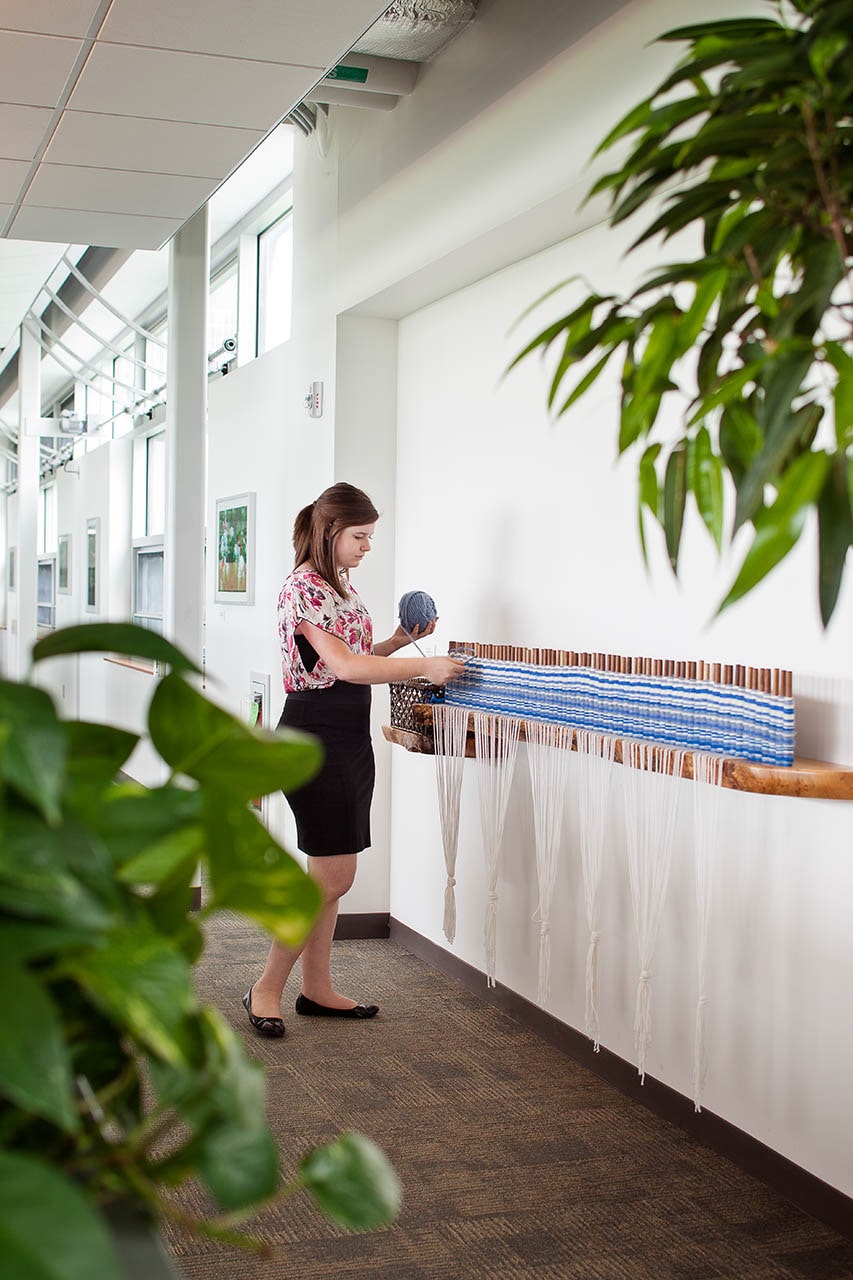
The Phipps Center for Sustainable Landscapes reached WELL Platinum Pilot Certification in October 2014.
À la LEED, a project can be certified as WELL Silver, WELL Gold, or WELL Platinum, and the web portal for uploading scorecard information for one automatically populates the relevant fields for the other. “We’ve been very mindful of that interconnection, not only from the perspective of sustainability and health being linked conceptually, but also in how the technical guts of the program have been developed and how the market would put it to use,” Moore says. For this reason, developers, designers, and financiers who are familiar with and see the value of LEED certification will find that WELL certification fits seamlessly into the same process from the perspective of implementation.
LEED has become a relatively straightforward business case based on the dual benefits of reducing energy consumption for both the environment and the bottom line. Although a sufficiently large dataset to verify the average implementation costs and return on investment associated with WELL does not yet exist, early indications are very promising. “Anecdotal evidence is that added costs for implementation are in the 1-to-2% range from what we’ve seen,” Moore says, basing the number on the handful of projects that have been built and certified so far and the budget projections for many others that are progressing through the pipeline.
Where LEED pays for itself in lower utility bills, the payback for the modest investment in the WELL Building Standard comes in the form of human capital, which has significant fiscal implications in itself. “In any building, 5-to-6% of it is ongoing energy costs,” says Scialla, “but 86% of the costs of any building are the people inside of it. So if we can focus on reducing that cost input and enhancing output, we have a staggering economic proposition.”
Translating those figures to square footage costs, Moore says annual energy costs in an office building might be in the $3-per- square-foot range, while corporations could spend around $300 per square foot on their employees. It is the cost-benefit ratio for the latter that puts the ROI for WELL on firm ground. She estimates that WELL certification costs for a typical corporate office space are going to be in the $100-per-employee range: “That’s two lunches or two weeks of coffee.”

At CBRE, 83% of employees say they feel more productive in the new building. 90% would recommend the new space to colleagues. 92% feel the new space has had a positive effect on their health and wellbeing. [Photo: Courtesy of CBRE]
“Occupant satisfaction in the building is as big a part of the WELL Building Standard as overall health,” says Stodola, citing poor sound proofing and lack of thermal comfort as the two biggest areas of complaints in the office space. WELL standards address these points in detail, along with many others that are linked to workplace health and happiness that employees may not be consciously aware of. The logic is that if air quality, lighting, ergonomics, and overall health and human comfort are improved, average employee sick days will go down and productivity will go up. “If the health and wellness benefits of that environment help eliminate one sick day per year for an employee or helps them to be more productive and engaged because they have a better sense of well-being and don’t feel crabby by 2 o’clock in the afternoon, then you have your payback,” Moore says.
Version one of the WELL Building Standard is optimized for office spaces, especially Class A owner occupied buildings that are likely to pursue LEED certification. Although they are still doing the homework to arrive at more concrete numbers for up-front and operational costs versus health benefits and ROI, everyone at IWBI concurs that WELL standards are essentially a value-added amenity to LEED standards. In this early stage of development, Moore says their first adoptees are largely “builders that know how to drive building performance and how to link that to a business case at the end of the day.”
IWBI is in the process of developing precise standards for retail, sports arenas, institutional environments, multi-family housing, and healthcare facilities, but in the meantime, the first WELL AP classes are forming to educate design professionals on using the standards in practice. “There is a long waiting list for enrollment,” says Moore, but announcements will be made throughout 2015 for additional dates to accommodate the demand.
How Does it Feel?
Now that several WELL-certified buildings are occupied, the long-term process of testing their performance is underway. CBRE recently published the results of an employee survey given after one year in their LEED Gold, WELL-certified office space in Los Angeles. 83% of employees say they feel more productive in the new building; 90% would recommend the new space to colleagues; 92% feel the new space has a positive effect on their health and wellbeing.
Haworth, an architectural interiors manufacturer using the WELL Building Standard, is carrying out similar studies at their Mexico City, Shanghai, and Los Angeles showrooms. “We’ve built process maps to calculate the time it takes to conduct typical work tasks and have developed statistical methods to see if any of the changes to the physical space had an actual impact to speed and time of business processes,” says Dr. Mike O’Neil, senior researcher at Haworth. Haworth is also collaborating with Delos to develop monitoring devices that will collect real-time data on performance measures like air quality and how people are actually using the space and “beam that back to the headquarters to make sure we’re in compliance over time,” O’Neil says.
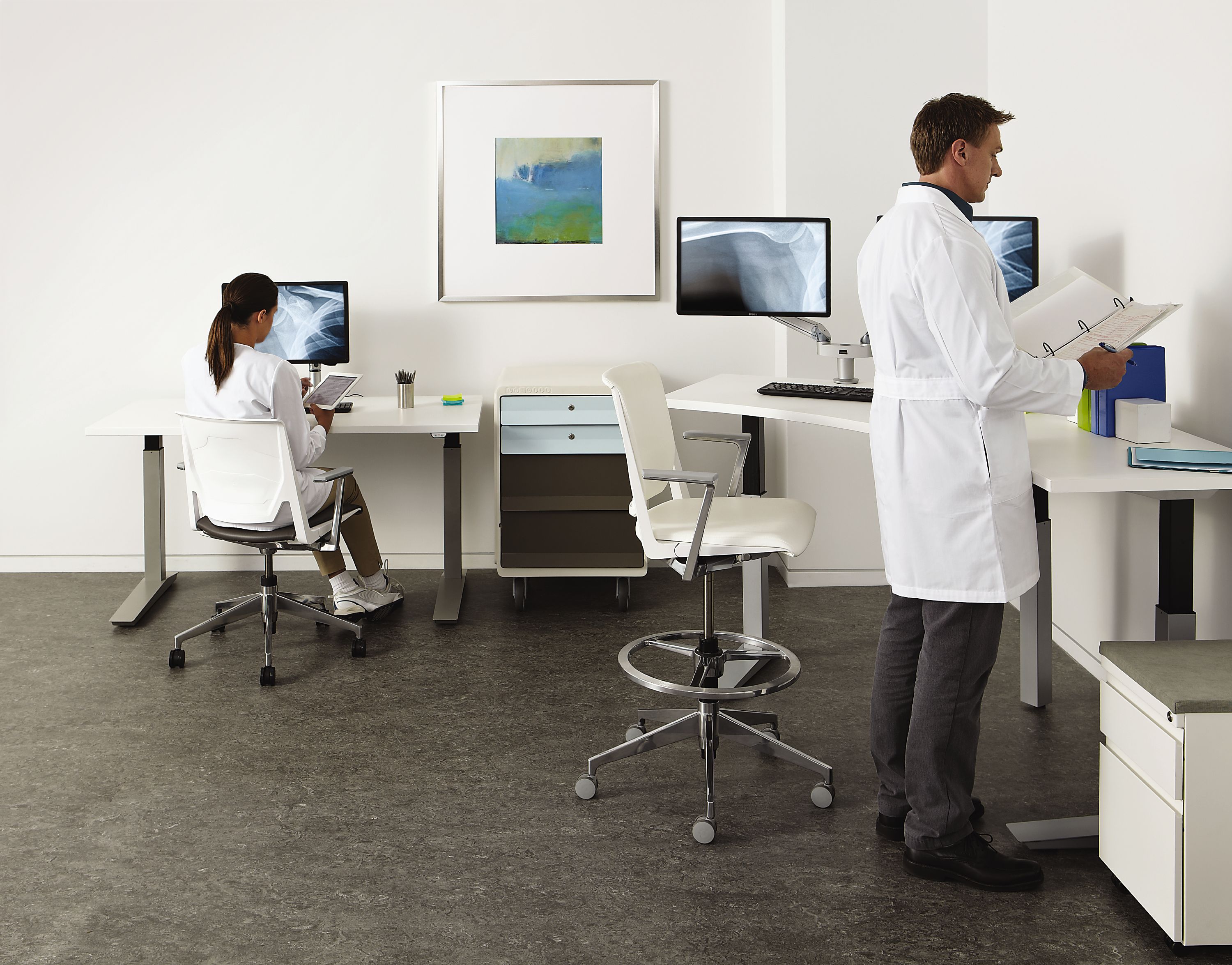
Haworth’s headquarters include WELL features, such as ergonomic seating, height adjustable tables, and more. While the HQ is not WELL Certified, the company’s Shanghai showroom is the first showroom registered for WELL Certification.
WELL may be a new way of building, but there is one person who has extensive experience with what it’s like to inhabit a WELL-certified space. “When we first started investigating this, I put a lot of these features into my own home,” says Scialla, the Delos founder. “My sleeping patterns are incredibly different than they used to be with the circadian lighting elements. I used to get a nasty cold three or four times a year and that has become quite infrequent. My energy levels have been through the roof.”
At last, a way of building to heal the ills of our sedentary society. “The time has come,” says Scialla.

